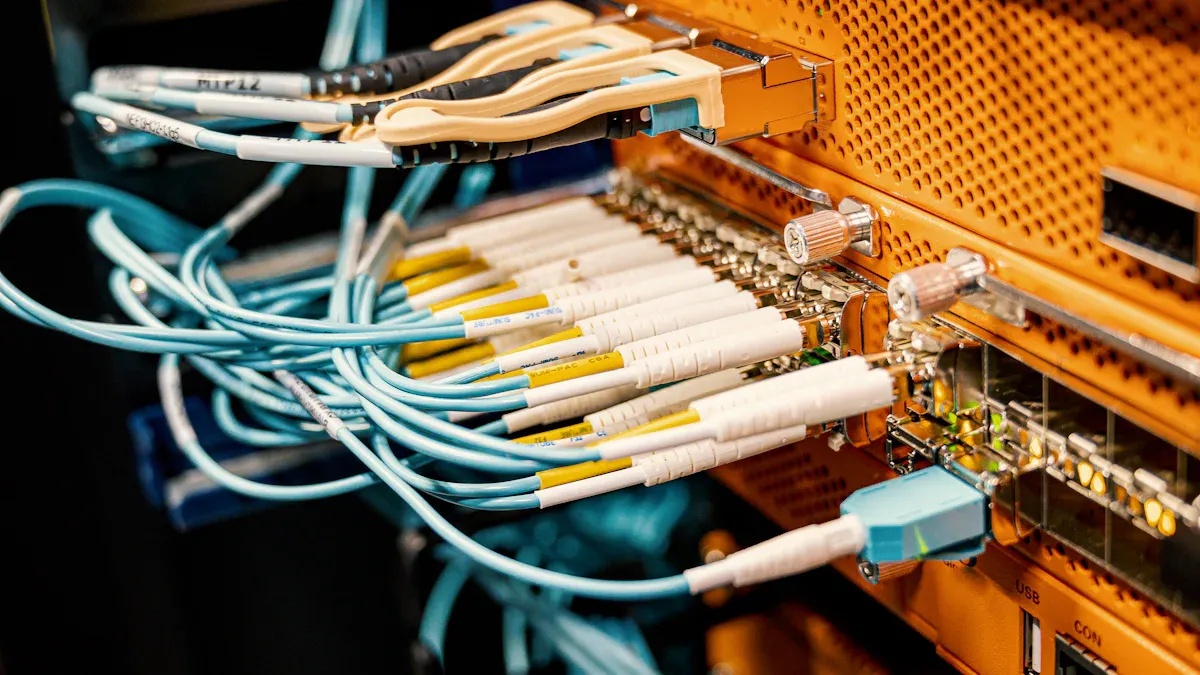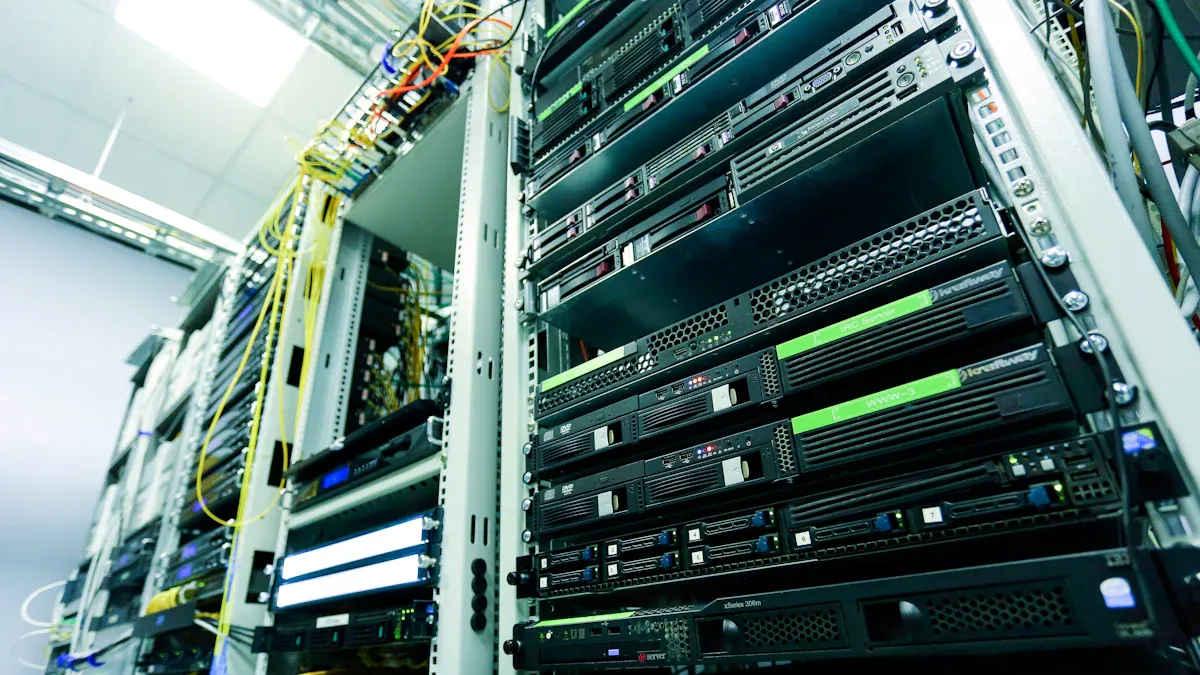Early Detection of Telecom Cabinet Power Anomalies: Hidden Early Warning Roles of Controller-Monitored Ripple Coefficient & Efficiency

Early detection of power anomalies in Telecom Cabinet Power systems plays a critical role in keeping networks reliable and efficient. Intelligent controllers now monitor ripple coefficient and efficiency in real time, sending automated alerts when unusual patterns appear. These alerts allow technicians to respond quickly, which cuts downtime and reduces the need for manual inspections or site visits. Operators notice that remote monitoring can speed up fault detection and repair, shorten mean time to repair, and extend equipment life. By identifying hidden early warning signals, smart monitoring helps lower operational costs and supports uninterrupted service.
Key Takeaways
Early detection of power anomalies in telecom cabinets keeps networks reliable and reduces downtime by alerting operators to issues before failures occur.
Controllers monitor ripple coefficient and efficiency in real time to spot early signs of equipment faults and abnormal power use, enabling faster maintenance.
Common causes of power anomalies include temperature changes, humidity, battery wear, and poor cabinet design, which can damage equipment and shorten lifespan.
Proactive maintenance uses integrated data from sensors and AI analytics to predict problems, reduce emergency repairs, and extend equipment life.
Implementing remote monitoring and smart controls improves energy efficiency, lowers costs, and supports uninterrupted telecom service.
Importance of Early Detection
Reliability and Uptime
Early detection of power anomalies in telecom cabinets ensures high network reliability and consistent uptime. Intelligent Power Distribution Units (PDUs) and Battery Management Systems (BMS) monitor key parameters such as voltage, current, and temperature. These systems identify common anomalies like overloads, voltage irregularities, thermal runaway, and internal short circuits. When controllers detect these issues early, they send alerts to operators, who can act before failures occur.
Note: Real-time monitoring and automated alerts help prevent unexpected failures and reduce downtime. Operators can respond quickly to anomalies, which keeps telecom networks running smoothly.
Telecom networks that use automated anomaly detection experience fewer service disruptions. For example, machine learning-powered detection allows for real-time identification of network issues. This leads to faster response times and fewer false alarms. As a result, networks maintain higher performance and reliability. Early detection also helps avoid prolonged outages, which can damage reputation and customer trust.
Cost Efficiency
Early detection of anomalies in telecom cabinets leads to significant cost savings. Predictive maintenance becomes possible when sensors and controllers provide accurate, real-time data. Operators can address small issues before they become expensive failures. This approach extends equipment life and reduces the need for emergency repairs.
Metric | Improvement / Impact |
|---|---|
Maintenance response times | 40% faster response, enabling quicker issue resolution |
Cost savings | 25% reduction in maintenance and repair costs |
Battery failure rates | 98% reduction through early detection |
Preventable outages | 80% of recent outages avoidable with monitoring |
Regular monitoring and prompt action lower the number of technician visits and unplanned outages. By reducing emergency repairs and focusing on targeted maintenance, telecom operators save money and resources. Early detection supports a more efficient and reliable telecom infrastructure.
Telecom Cabinet Power Anomalies

Common Causes
Telecom Cabinet Power systems face many challenges that can lead to power anomalies. Environmental factors play a major role in causing these issues.
Temperature fluctuations and humidity speed up equipment wear and promote corrosion.
Battery degradation often results from overcharging, undercharging, and thermal stress, which reduces efficiency and shortens lifespan.
Moisture ingress, condensation, and corrosion from humidity or rain damage sensitive electronics.
Severe weather events such as thunderstorms, hurricanes, and winter storms frequently cause power outages, especially at remote sites.
Poor cabinet design can allow water and dust to enter, increasing the risk of failure.
Modern cabinets use several features to prevent these problems. Double-layer sealing blocks water and dust during storms. Composite insulation helps control internal temperature swings. Stainless steel with anti-corrosion coatings increases durability in humid or coastal areas. Strong frames resist wind and physical impacts. Intelligent monitoring systems send real-time alerts, supporting predictive maintenance and rapid response.
Cabinets also use passive and active cooling systems, including ventilation fans and heat exchangers, to maintain safe operating conditions. Surge protection modules and grounding systems shield equipment from voltage surges caused by lightning or grid faults.
Impact on Systems
Power anomalies in Telecom Cabinet Power setups can have serious effects on critical equipment.
Thermal stress and increased heat often lead to equipment failure and reduce lifespan.
Overheating, condensation, and corrosion damage sensitive components, causing unexpected breakdowns.
Battery strain from power fluctuations speeds up capacity loss and self-discharge, shortening battery life.
Lack of real-time monitoring prevents early detection, allowing small issues to grow into major failures.
Maintaining recommended temperature and humidity levels is essential. High temperatures can cause up to 35% battery capacity loss. Efficient power management lowers heat generation, preventing thermal stress and equipment degradation. Remote monitoring and smart controls enable operators to act before damage occurs, reducing breakdowns and network outages. Oversized solar systems and backup planning improve reliability and reduce maintenance costs. Energy-saving features like ECO mode extend equipment lifespan by reducing power draw during light loads.
Impact | Description |
|---|---|
Equipment failure | Caused by overheating and corrosion |
Reduced battery life | Result of power fluctuations and thermal stress |
Increased maintenance | More frequent repairs and higher costs |
Service disruptions | Network outages and loss of reliability |
Controller Monitoring Functions

Ripple Coefficient Signals
Controllers in Telecom Cabinet Power systems serve as the logic center for managing rectifiers, batteries, and power distribution units. They monitor the ripple coefficient, which measures the small voltage fluctuations superimposed on the DC output. These fluctuations can signal early-stage faults or degradation in rectifier modules. Intelligent controllers track these signals in real time and compare them to preset thresholds. When the ripple coefficient rises above safe limits, the controller generates an alert for operators.
Controllers provide network communication capabilities, allowing integration with network management platforms.
They enable remote access and real-time monitoring, which supports predictive maintenance.
Ripple coefficient monitoring helps identify issues such as faulty rectifiers, loose connections, or failing capacitors before they cause major failures.
Advanced protection features, including automated shutdown and fault isolation, enhance system reliability and safety.
Tip: Early detection of abnormal ripple signals allows operators to schedule maintenance before equipment suffers damage or service interruptions.
Controllers also support diagnostic and service features. They can detect ground faults and other electrical anomalies, which helps prevent safety hazards and equipment loss. By monitoring ripple coefficient trends, controllers give operators a hidden early warning system for power quality issues.
Efficiency Tracking
Efficiency tracking in Telecom Cabinet Power systems uses real-time data from sensors that measure temperature, humidity, airflow, and battery health. Controllers analyze this data to spot abnormal power consumption patterns. When efficiency drops, the system may signal problems such as cooling failures, airflow blockages, or battery degradation.
Threshold alerts notify operators when environmental parameters exceed safe limits, enabling early intervention.
Airflow monitoring with differential pressure sensors detects blockages or leaks that increase power consumption.
Thermal mapping and hot spot detection reveal abnormal temperature rises linked to inefficient power use.
Remote monitoring systems collect continuous data, allowing operators to analyze trends and spot deviations from normal patterns.
AI-driven analytics help predict failures and optimize cooling, which improves energy efficiency and identifies abnormal power consumption.
Controllers maintain continuous monitoring, even during power outages, by using backup systems. This ensures that anomaly detection remains active at all times.
Benchmark Aspect | Details and Impact |
|---|---|
Target Efficiency | At least 99% energy efficiency recommended for telecom rectifiers to minimize losses and costs. |
Ideal Efficiency Range | 96% to 98% efficiency balances energy savings, cost reduction, and sustainability goals. |
Efficiency Improvement Trend | Conversion efficiency improved from 94% to 98% over the past decade, reducing power loss by 66%. |
Advanced Technologies | Silicon carbide (SiC) and gallium nitride (GaN) enable efficiencies between 97% and 98.5%. |
Modular Design Benefits | Modular, scalable rectifiers combined with AI-driven maintenance optimize efficiency and uptime. |
Case Study: Leading Telecom | Achieved 97.8% efficiency, early issue detection, and network expansion without downtime. |
Case Study: GreenConnect | Reduced energy use by 30%, downtime by 25%, and CO₂ emissions by 40%. |
Note: Operators use these benchmarks to evaluate system performance and set maintenance priorities. High efficiency not only reduces costs but also supports sustainability goals.
Controllers in Telecom Cabinet Power systems combine ripple coefficient signals and efficiency tracking to provide a comprehensive early warning system. They support diagnostic, service, and ground fault detection features, which help operators maintain reliable and efficient network operations.
Proactive Maintenance Strategies
Data Integration
Data integration forms the backbone of proactive maintenance in modern telecom infrastructure. Operators use IoT-enabled systems to connect sensors, controllers, and devices, collecting real-time data on environmental and power conditions. These systems aggregate information from temperature, humidity, and power sensors into centralized dashboards. This unified view allows operators to monitor multiple sites and quickly identify anomalies.
Centralized platforms support secure communication protocols and open connectivity standards. Features like API access and SNMP support enable seamless integration with existing IT and network management systems. Operators receive real-time alerts and actionable insights through embedded analytics, which help them respond immediately to abnormal events. Many telecom operators leverage 5G networks for high-speed, low-latency data transmission, ensuring that monitoring remains effective even as network demands grow.
Cloud-based IoT management platforms play a key role in trend analysis and performance optimization. These platforms allow operators to forecast failures and schedule timely interventions. AI-driven anomaly detection and automated incident categorization speed up response times and reduce manual triage. Modular and intelligent Power Distribution Units with IoT connectivity support scalable deployment and remote management, making it easier to expand or upgrade systems as needed.
Operators often face challenges such as managing large volumes of real-time data, ensuring interoperability between multi-vendor systems, and maintaining cybersecurity. They address these issues by using modular sensor designs, centralized data aggregation, and robust risk management strategies.
Implementation Steps
Implementing proactive maintenance strategies in Telecom Cabinet Power systems involves several key steps. These steps help operators maximize system reliability and minimize downtime.
Site Assessment and Data Collection
Operators begin with a thorough site assessment using digital twin models, aerial drone imagery, and interior scans. This process captures comprehensive data and verifies site conditions. Accurate 3D point cloud models enable precise representation of the telecom site, supporting AI-assisted analysis.Centralized Data Integration
All relevant data, including CAD drawings, 3D models, photos, and inventory, are integrated into a centralized platform. This approach improves collaboration and accelerates decision-making. Operators select hardware components tailored to site needs, prioritizing modularity, weather resistance, and compatibility with existing protocols.Sensor and Connectivity Selection
Operators choose sensors appropriate for environmental conditions to ensure accuracy and reliability. Reliable connectivity options, such as cellular or satellite, are established based on site location. Security features like TLS encryption and programmable access rights protect data and system integrity.System Testing and Validation
Rigorous testing and validation follow installation. Operators simulate real-life conditions, perform load and functional tests, and re-test after upgrades. Ongoing system health monitoring includes routine inspections, software updates, and prompt response to alerts.Staff Training and Documentation
Operators train staff to recognize early warning signs and respond to system alerts. Detailed maintenance documentation and incident response plans support troubleshooting and continuous improvement.Continuous Monitoring and Predictive Maintenance
Real-time monitoring of output voltage, current, and efficiency enables early detection of inefficiencies and faults. Predictive maintenance tools detect abnormal temperature changes and voltage fluctuations, supporting proactive fault identification. Remote inspection capabilities via web interfaces and mobile apps enhance maintenance efficiency.Risk Planning and Redundancy
Operators implement redundant power configurations, such as N+1 or N+2, to ensure continuous operation during module failures. Hot-swappable modules allow repairs without service interruption. Comprehensive risk planning involves analyzing historical outage data and upgrading infrastructure to prevent downtime.
Proactive monitoring and maintenance minimize faults, reduce downtime, and maintain rectifier modules at peak efficiency. Operators shift from reactive to predictive maintenance, optimizing resource allocation and extending equipment life.
Operators may encounter challenges such as data overload, interoperability issues, and cybersecurity threats. They address these by using dynamic analytics, modular solutions, and robust security measures. Real-world deployments show that integrated monitoring solutions can reduce energy use by up to 30% and downtime by 25%, demonstrating the effectiveness of these strategies.
Controller-monitored ripple coefficient and efficiency offer early warning signals that help organizations detect Telecom Cabinet Power anomalies before they cause disruptions.
Intelligent monitoring enables real-time tracking and predictive maintenance, reducing unexpected outages.
Proactive strategies such as regular inspections and balanced loads improve energy efficiency and extend equipment lifespan.
Advanced systems support remote management, scalable expansion, and better capacity planning.
AI-driven technologies and smart sensors enhance operational reliability and future-proof telecom infrastructure.
FAQ
What is the ripple coefficient in telecom cabinet power systems?
The ripple coefficient measures small voltage fluctuations in DC output. Controllers monitor this value to detect early signs of rectifier faults or capacitor issues. High ripple coefficients often indicate equipment degradation or loose connections.
What role does efficiency tracking play in anomaly detection?
Efficiency tracking helps operators spot abnormal power consumption. Controllers analyze sensor data to identify cooling failures, airflow blockages, or battery problems. Early detection of efficiency drops allows technicians to prevent equipment damage and reduce energy costs.
What benefits do controller-monitored parameters offer for maintenance?
Controller-monitored ripple coefficient and efficiency provide early warning signals. Operators use these alerts to schedule maintenance before failures occur. This approach reduces downtime, extends equipment life, and lowers operational costs.
What challenges do operators face when integrating monitoring systems?
Operators often manage large volumes of real-time data and ensure compatibility between devices. They address these challenges by using modular sensors, centralized dashboards, and secure communication protocols.
What technologies support proactive maintenance in telecom cabinets?
IoT-enabled sensors, AI-driven analytics, and cloud-based platforms support proactive maintenance. These technologies enable real-time monitoring, predictive maintenance, and remote management, helping operators maintain reliable and efficient telecom infrastructure.
See Also
Steps To Guarantee Consistent Power For Telecom Cabinets
Best Practices For Effective Monitoring Of Outdoor Telecom Cabinets
Methods To Calculate Power Systems And Batteries For Telecom Cabinets
Exploring Various Cooling Techniques And Their Uses In Telecom Cabinets
CALL US DIRECTLY
86-13752765943
3A-8, SHUIWAN 1979 SQUARE (PHASE II), NO.111, TAIZI ROAD,SHUIWAN COMMUNITY, ZHAOSHANG STREET, NANSHAN DISTRICT, SHENZHEN, GUANGDONG, CHINA

